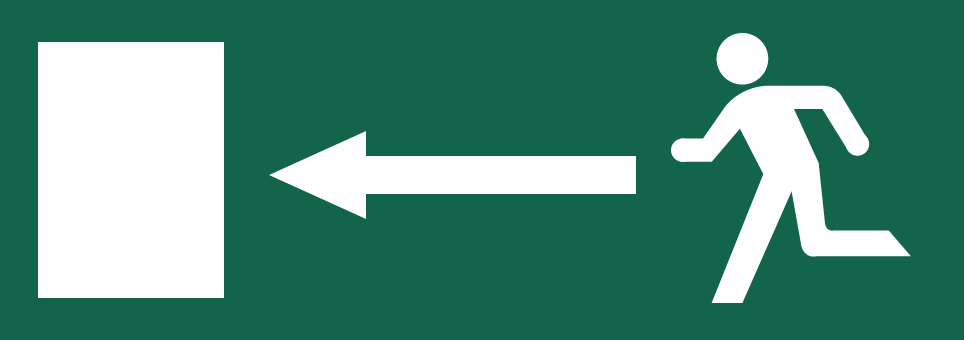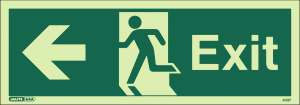Escape Route Signs
Exit Sign Design History
The ‘Euro-sign’ versus BS 5499-1 sign confusion
Ever since the introduction of the EEC Directive (EEC/92/58) in 1992, the sign industry has been in confusion and uncertainty spread amongst those who needed to specify fire signs.
There are broadly two main types of emergency exit route and final exit signs in use in the UK. One, commonly referred to as ‘Euro sign’ was based on the EEC Directive (EEC/92/58) and one was based on the British Standard BS 5499: Part 1.
| The ‘Euro-Sign’ |  |
||
|---|---|---|---|
| The BS 5499-1 sign |  |
||
How did this happen?
Fire exit route and final exit signs were originally text only and included an arrow for travel direction only when appropriate. However, the European Community decided that there should be a sign or series of signs that should offer common symbols for communication across European Community states. It was decided that a graphical symbol or pictogram should be the main element of the sign, enabling it to be understood independently of language. The EEC Directive (EEC/92/58) in 1992 was produced to deal with the sign design criteria of prohibition, warning, mandatory; escape routes and final exit signs. It is the criteria specific to the escape routes and exit signs shown in the Directive that has caused the ‘Euro-sign’ to become so widely used. In Annex 2, ‘Minimum General Requirements Concerning Signboards’, section 1.3. discusses escape routes and final exit sign designs and shows the ‘Euro signs’ as examples of the design criteria. This introduction of the EEC Directive (EEC/92/58) and in particular the reference to Annex 2 has resulted in the ‘Euro-sign’ design being chosen by a number of sign companies.
Other sign manufacturers, particularly those in the fire industry, while accepting the requirement of the directive for common graphical symbols, recognised that some research and work to develop this type of graphical symbol had already been successfully implemented in the BS 5499: Part 1: 1990 standard. The BS symbols, which were also accepted by the Health and Safety Executive and HM Inspectorate, were chosen to meet the new requirements. With two official documents containing two different design styles, it is no surprise that there now exists a cocktail of sign designs within the UK’s public and commercial buildings. As a result, the sign industry often clashed over which is the correct sign, neither sign can afford to be ‘wrong’. They had set their production lines according to the design they had chosen at a considerable capital cost and the potential cost of replacing signs already sold, which could become a demand if their sign type was to be proven unacceptable, must also be considered.
The solution
An international standard, ISO 3864, became BS ISO 3864 and has replaced BS5499-1. This new standard, which is very similar to BS 5499-1, finally resolves the issue of varying fire exit signs. Signs manufactured to BS5499 should conform to the new standard.
The over-arching standard ISO 7010 (Graphical symbols-Safety colours and safety signs-Registered safety signs), which refers to ISO 3864 for the precise design of fire exit signs, became BS EN ISO 7010 and introduced consistency within Europe, being automatically adopted as the domestic standard within all member states of the European Union. All workplaces, including merchant and passenger vessels will be required to implement and display the new graphical symbols for safety communication. The objective is to ensure that graphical symbols with the highest comprehension credentials are used.
Again, signs manufactured to BS 5499 should conform, as long as the installation is in line with the new standard.
Categories:Fire Safety Equipment
March 16, 2011[Last updated: January 8, 2022]
Comments are closed here.